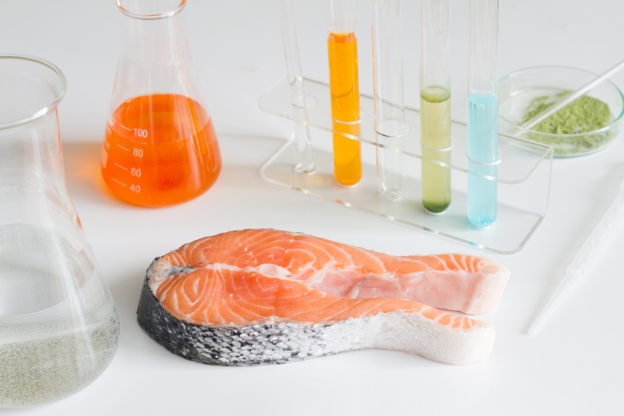By David Blyweiss, M.D., Advanced Natural Wellness
December 26, 2018
Every now and then I run across a patient who won’t eat fish. It’s not because they don’t like it. It’s because they’ve read one too many scary stories about mercury poisoning.
I get it. And I agree that all heavy metals, not just mercury, are a problem in today’s society.
However, this may be one instance where avoiding a specific food group for “health reasons” may actually be doing more harm than good.
Seafood is one of your best sources of fats, protein, vitamins, and minerals that promote good health. Regular fish consumption can…
- Reduce the risk for heart disease.
- Provide relief from inflammatory diseases.
- Improve lipid metabolism
- Reduce the likelihood of high blood pressure.
- Drop your chances of developing artery-clogging plaque or blood clots.
- Diminish the risk of sudden death from a heart attack or stroke.
- Improve blood sugar and insulin sensitivity.
- Decrease joint pain and stiffness among people with arthritis.
- Improve bone health.
- Improve mood.
- Slow aging.
- Lower the risk of macular degeneration.
- Reduce the risk for colon cancer, and possibly breast and prostate cancers.
So that’s a pretty long list.
Still, how can you get all of these great and wonderful health benefits without worrying about mercury?
I’ll tell you the exact same thing I tell my patients.
DO NOT eat fish that are high on the food chain. Those that are larger and live longest are the ones that have the highest mercury levels. Swordfish, King and Spanish mackerel, grouper, Chilean sea bass, tuna (all types… sorry Charlie), marlin, shark, tilefish, orange roughy and halibut all fall under this category.
DO eat smaller forms of seafood. Shrimp, scallops, sardines, wild Alaskan salmon and oysters are all extremely low on the food chain. Haddock, Pollock, flounder, sole, catfish, trout, mackerel and crab also contain very low mercury levels.
NEVER buy regular canned albacore tuna. If you insist on tuna from a can, select “light tuna”. It is generally made from skipjack tuna, which has about a third of the mercury content of albacore. Better yet, choose canned wild salmon instead.
ALWAYS buy wild-caught to avoid hormone disrupting contaminants found in farm-raised seafood.
4 Mercury-Busting Tips for Everyone (Not Just Fish Lovers)
Fish isn’t the only source of mercury in your environment. It’s in amalgam dental fillings, light switches, thermostats, some vaccines and even some cosmetics.
The World's Quickest Solution for Ending Prostate and Urinary Misery
This has recently been revealed to be one of the only real breakthroughs in prostate health.
The seeds of a strange fruit (sometimes called "Chinese Apples") hold powerful phytonutrients that are a revolution in prostate health.
In fact, UCLA and Veterans Administration research have now proved this to be true.
Not only that, but it may be the worlds quickest solution for ending prostate misery.
Simply stated, these phytonutrients represent a huge step beyond beta sitosterol, saw palmetto, and other phytosterols alone.
Simply click HERE if you want to have fast prostate relief...restful, uninterrupted sleep...no more constant "urges to go"...enhanced virility...and optimal prostate support for life.
So it’s a great idea to give your body the tools it needs to remove it before it can build to harmful levels.
You can start with a diet high in fresh, organic vegetables. In particular, toxic metals like mercury have an affinity for binding to sulfur-containing foods such as garlic, onion, broccoli, kale, cauliflower, leeks and bok choy.
Then, add in some healthy sources of fiber to help reduce levels of mercury in your brain and blood. Lentils, beans and other legumes are my top choices. Avocados, artichokes and green peas all have a high fiber content. Nuts and seeds are good, too.
I also recommend eating berries of all kinds to get more healthy fiber in your diet, especially blackberries, raspberries and blueberries. If you’re not fond of berries, coconut, pears, apples, apricots and figs also contain appreciable amounts of fiber.
Next, start supplementing with N-acetyl cysteine (NAC) and alpha lipoic acid (ALA). These two glutathione precursors act as chelators to help bind and move mercury and other metals out of your body faster.
Last but not least start on a chlorella or spirulina supplement. These are forms of algae that are rich in chlorophyll that collects and removes mercury and other heavy metals.
Oh! One more thing…
If you don’t eat fish, for whatever reason, I recommend supplementing with a premium mercury-free fish oil supplement. Otherwise you’ll miss out on all of those amazing health benefits I mentioned earlier. Take between 2,000 and 4,000 mg daily.
Sources:
Yashodhara BM. Omega-3 fatty acids: a comprehensive review of their role in health and disease. Postgraduate Medicine Journal. 2009;85:84-90
Hosomi R, et al. Seafood Consumption and Components for Health. Glob J Health Sci. 2012 May; 4(3): 72–86.
Kiecolt-Glaser JK, et al. Omega-3 fatty acids, oxidative stress, and leukocyte telomere length: A randomized controlled trial. Brain Behav Immun. 2012 Sep 23.
Sears ME. Chelation: Harnessing and Enhancing Heavy Metal Detoxification—A Review. ScientificWorldJournal. 2013; 2013: 219840.







Wild salmon is not free of mercury–far from it. For years I ate Whole Foods salmon, caught in supposedly uncontaminated waters of the north Atlantic. I had symptoms that prompted me to have my mercury level tested. I was at the high end, the edge, of normal for mercury. I switched to white colored fish from Whole Foods. My mercury level was almost four times higher! Add to this the risk of radioactive particles from the Fukushima reactor melt-down (which the media is no longer covering but which continues since 2010), and no fish is safe to eat.